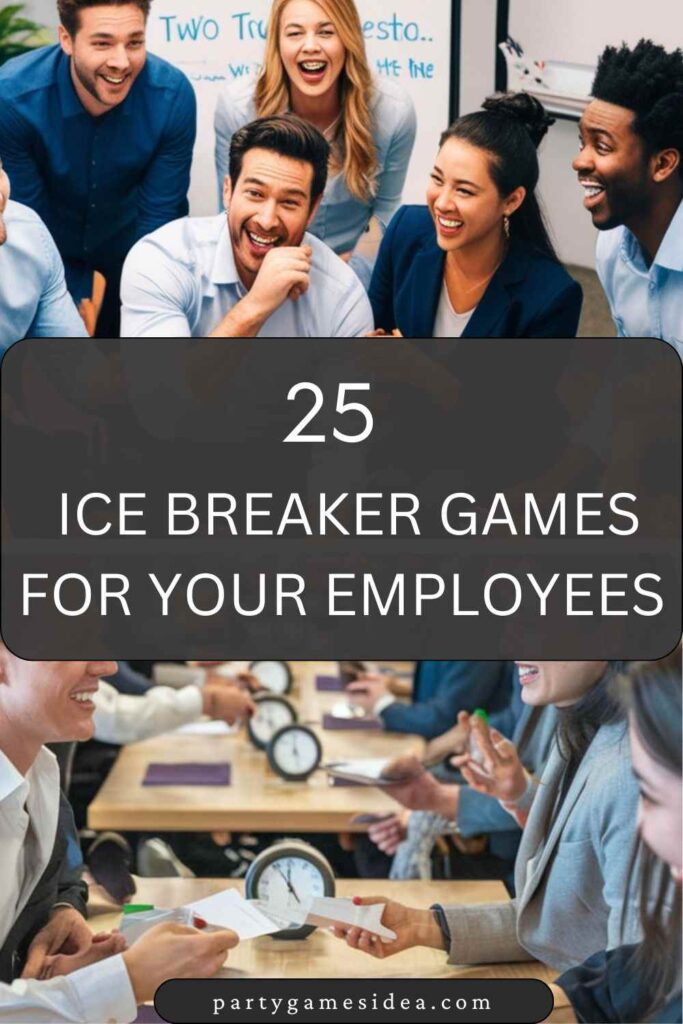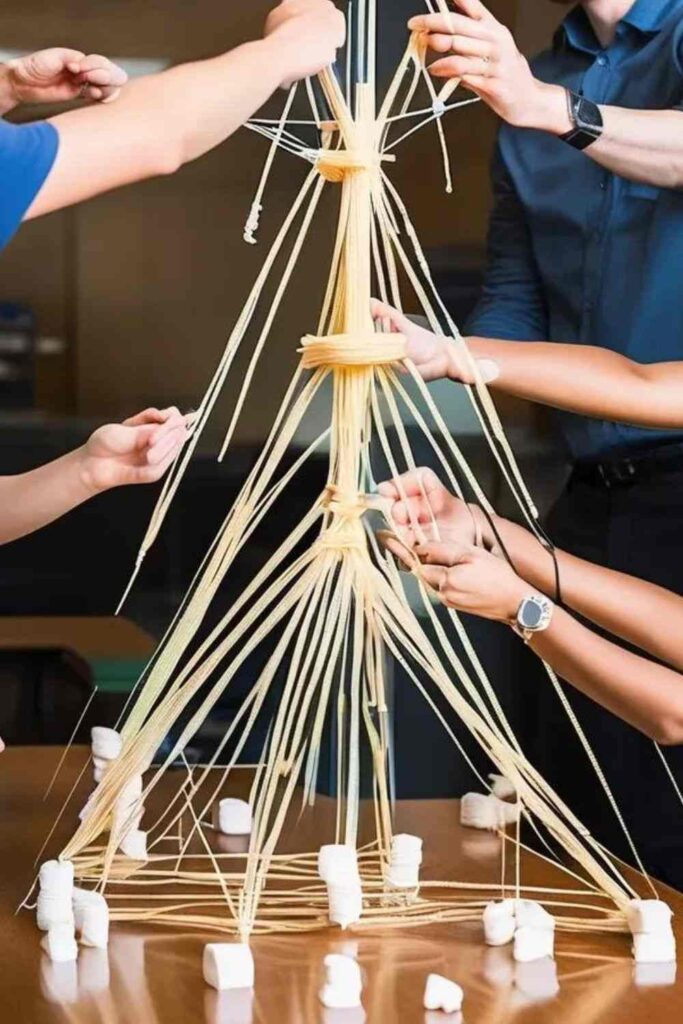In today’s dynamic work environment, Ice Breaker Games For Employees have become a crucial tool for fostering a positive and productive workplace. These games are not just fun activities but essential components for creating a cohesive team. By engaging in Ice Breaker Games, employees can build team cohesion, which is vital for creating a unified and supportive work culture. When team members get to know each other better and share experiences outside of their usual work routines, they develop stronger interpersonal relationships and a greater sense of belonging.
Additionally, Ice Breaker Games play a significant role in reducing stress and easing tension within the workplace. Starting a meeting or event with a light-hearted game can help employees unwind and shift their focus away from work-related pressures. This approach not only alleviates immediate stress but also contributes to a more relaxed and enjoyable work environment.
Moreover, these games encourage communication and collaboration among employees. Through interactive and engaging activities, team members are prompted to interact more openly and work together towards common goals. This enhanced communication helps break down barriers and fosters a collaborative spirit, essential for effective teamwork and innovation. In summary, Ice Breaker Games For Employees are an invaluable resource for creating a harmonious and productive workplace by building team cohesion, reducing stress, and encouraging effective communication and collaboration.
Ice Breaker Games For Employees
Ice Breaker Games for Employees are fun activities designed to help team members get to know each other, build trust, and foster collaboration. They create a relaxed and engaging atmosphere, making it easier for colleagues to communicate and work together effectively.
Two Truths and a Lie Game Challenge
A classic and engaging game where each participant shares two true statements and one false statement about themselves. This activity helps employees learn more about each other in a fun and interactive way.
Rules
- Each person states two true facts and one lie about themselves.
- The rest of the group guesses which statement is the lie.
- Participants reveal the lie after guesses are made.
Tips
- Encourage creativity with the statements to make it more interesting.
- Keep the facts light-hearted and non-sensitive.
- Use it as a warm-up for more in-depth team activities.
Speed Networking
A structured way to ensure everyone meets and interacts with each other briefly. Ideal for large teams or new employees to quickly get acquainted.
Rules
- Pair up employees for short, timed conversations (e.g., 3 minutes each).
- Rotate pairs until everyone has met.
- Provide conversation prompts if needed.
Tips
- Use a timer to keep the activity moving.
- Encourage participants to share something unique about themselves.
- Ensure everyone has a chance to participate.
The Marshmallow Game Challenge
A team-building activity that involves constructing the tallest tower using spaghetti, tape, string, and a marshmallow. It emphasizes creativity and teamwork.
Rules
- Teams receive a kit with spaghetti, tape, string, and a marshmallow.
- Build the tallest free-standing tower with the marshmallow on top.
- Complete the challenge within a set time limit.
Tips
- Encourage teams to plan before building.
- Allow time for testing and adjustments.
- Highlight the importance of teamwork and communication.
Office Trivia Game
A fun and competitive game where employees answer trivia questions related to the office or company history. It’s a great way to test knowledge and engage employees.
Rules
- Prepare a list of trivia questions about the office or company.
- Participants answer questions individually or in teams.
- Award points for correct answers and tally the scores.
Tips
- Mix easy and challenging questions to keep everyone engaged.
- Use a quiz format for faster-paced play.
- Include fun facts to enhance interest.
Office Pictionary
A drawing game where participants illustrate words or phrases while their team guesses what’s being drawn. It fosters creativity and quick thinking.
Rules
- Players draw a word or phrase for their team to guess.
- Set a time limit for each drawing session.
- Teams earn points for correct guesses.
Tips
- Use a Pictionary app or whiteboard for drawing.
- Choose words or phrases related to your industry for added fun.
- Keep the atmosphere relaxed and encouraging.
Office Escape Room Challenge
A problem-solving game where teams work together to solve puzzles and “escape” a themed room within a set time. It’s excellent for fostering collaboration and critical thinking.
Rules
- Teams are given clues and puzzles to solve.
- Work together to decipher clues and unlock the escape room.
- Complete the challenge within the allotted time.
Tips
- Choose an escape room with difficulty appropriate for the team.
- Encourage teamwork and communication.
- Debrief after the activity to discuss strategies and solutions.
Trust Fall
A classic trust-building exercise where one person falls backward, trusting their teammates to catch them. It helps build trust and confidence among team members.
Rules
- One person stands with their back to the team and falls backward.
- The team members catch the person and gently lower them to the ground.
- Rotate roles to ensure everyone participates.
Tips
- Ensure a safe and soft landing area.
- Emphasize the importance of trust and communication.
- Make sure participants are comfortable with the activity.
Build-a-Story
A creative activity where participants contribute sentences to build a collaborative story. It promotes imagination and group creativity.
Rules
- One person starts a story with a sentence.
- Each participant adds a sentence in turn.
- The story continues until everyone has contributed.
Tips
- Encourage imaginative and humorous contributions.
- Use prompts or themes to guide the story.
- Share the final story with the group for a fun conclusion.
A Human Bingo
An interactive game where employees must find colleagues who fit certain descriptions on a bingo card. It’s a great way to spark conversations and discover common interests.
Rules
- Create bingo cards with different descriptions (e.g., “Has traveled to Asia”).
- Participants mingle to find colleagues who match the descriptions.
- The first person to complete a row or column wins.
Tips
- Tailor descriptions to match your team’s interests.
- Set a time limit to keep the game dynamic.
- Encourage participants to have brief conversations with each other.
Virtual Coffee Breaks
An informal online gathering where remote employees can chat and socialize over coffee. It’s perfect for building connections in a virtual environment.
Rules
- Schedule a regular virtual coffee break using a video conferencing tool.
- Participants join with their favorite beverages and chat casually.
- Keep the conversation light and open-ended.
Tips
- Set a regular time to establish a routine.
- Encourage participants to share personal interests or updates.
- Keep the atmosphere relaxed and inclusive.
Online Quizzes
A fun and interactive way for employees to test their knowledge on various topics through online quizzes. It’s ideal for engaging remote teams.
Rules
- Create or use an online quiz platform to design quizzes.
- Share the quiz link with participants.
- Participants complete the quiz, and scores are reviewed.
Tips
- Choose quizzes related to company trivia or general knowledge.
- Keep quizzes short to maintain interest.
- Provide immediate feedback and discuss answers afterward.
Virtual Show and Tell
A virtual activity where employees share and discuss personal items or achievements with their colleagues. It’s a great way to learn more about each other’s interests.
Rules
- Participants choose an item to share on a video call.
- Each person takes a turn to present their item and explain its significance.
- Allow time for questions and discussion.
Tips
- Encourage participants to choose items they’re passionate about.
- Keep presentations brief to allow everyone a turn.
- Foster an inclusive and supportive environment.
Scavenger Hunt
An engaging game where employees search for specific items or complete tasks based on clues. It’s perfect for team-building and problem-solving.
Rules
- Create a list of items or tasks for participants to find or complete.
- Set a time limit for the scavenger hunt.
- Participants or teams report back with their findings or completed tasks.
Tips
- Tailor clues and tasks to be relevant to the work environment.
- Use a mix of easy and challenging items to keep it exciting.
- Offer small rewards for completing the hunt.
Office Charades
A lively game where participants act out words or phrases without speaking while their team guesses what it is. It’s great for encouraging creativity and teamwork.
Rules
- Write down words or phrases related to work or general topics.
- Players take turns acting out the words or phrases for their team.
- Teams guess the correct answers within a time limit.
Tips
- Use a charades app or prepare slips with phrases in advance.
- Choose a mix of easy and challenging words to balance the game.
- Keep the environment supportive and encouraging.
Who Am I?
A guessing game where participants wear sticky notes with names of famous people or characters on their foreheads and ask yes/no questions to figure out who they are.
Rules
- Each participant receives a sticky note with a name or character.
- Players ask yes/no questions to guess their identity.
- The game continues until everyone has guessed correctly.
Tips
- Choose a range of well-known names for variety.
- Allow time for questions and guessing.
- Encourage creativity in questions to make it more fun.
Icebreaker Bingo
A variation of Human Bingo where employees mark off squares on a bingo card based on activities or characteristics. It’s a fun way to learn about colleagues.
Rules
- Create bingo cards with different activities or traits.
- Participants find colleagues who match each square.
- Complete a row, column, or full card to win.
Tips
- Customize the bingo squares to match your team’s interests.
- Set a time limit to keep the game lively.
- Encourage conversations and interactions while playing.
Memory Lane
A nostalgic game where employees share memorable experiences from their past. It helps build connections through shared stories and personal insights.
Rules
- Ask participants to share a memorable experience or fun fact from their past.
- Each person takes a turn to share their story.
- Discuss and reflect on the shared experiences.
Tips
- Encourage sharing positive or humorous stories.
- Create a safe space for personal sharing.
- Use this game to build rapport and deepen connections.
Mystery Guest
A game where a “mystery guest” joins a meeting or event, and participants guess who they are based on clues. It adds an element of surprise and excitement.
Rules
- Invite a guest to join the meeting with a unique background.
- Provide clues about the guest’s identity throughout the event.
- Participants guess who the guest is based on the clues.
Tips
- Choose a guest with an interesting or relevant background.
- Give clues gradually to maintain suspense.
- Ensure the guest is comfortable with the activity.
Collaborative Drawing
A creative game where team members contribute to a single drawing. It promotes teamwork and creativity as everyone adds their own touch to the artwork.
Rules
- Start a drawing on a shared digital whiteboard or large paper.
- Each participant adds to the drawing in turn.
- Complete the drawing and discuss the final result.
Tips
- Encourage participants to be imaginative and collaborative.
- Use a shared digital tool for remote teams.
- Display the finished drawing as a team achievement.
Team Jigsaw Puzzle
A collaborative activity where employees work together to complete a jigsaw puzzle. It fosters teamwork and problem-solving skills.
Rules
- Provide a jigsaw puzzle for the team to complete.
- Team members work together to fit the pieces and complete the puzzle.
- Set a time limit or complete it as a team-building exercise.
Tips
- Choose a puzzle with an appropriate difficulty level.
- Encourage collaboration and communication.
- Celebrate the completed puzzle as a team success.
Emoji Storytelling
A fun and modern game where participants use emojis to create and share stories. It encourages creativity and digital communication.
Rules
- Participants use emojis to create a short story.
- Share the emoji stories with the group.
- Everyone guesses the story’s meaning or interprets it.
Tips
- Use a range of emojis to enhance creativity.
- Allow time for everyone to create and share their stories.
- Keep the stories light and humorous.
Desk Decoration Contest
A light-hearted competition where employees decorate their desks according to a theme. It adds a fun and personal touch to the workplace.
Rules
- Choose a theme for desk decoration (e.g., “Summer Vibes”).
- Employees decorate their desks according to the theme.
- Judges or colleagues vote for the best-decorated desk.
Tips
- Set clear guidelines for the theme and decorations.
- Encourage creativity and personal expression.
- Offer small prizes for the best decorations.
Guess the Desk
A game where participants guess which desk belongs to which employee based on clues or photos. It’s a fun way to learn about colleagues’ personalities.
Rules
- Collect photos or descriptions of different desks.
- Participants guess which desk belongs to which employee.
- Reveal the correct answers after the guesses.
Tips
- Ensure desks are recognizable and distinguishable.
- Use the game as an ice breaker at a team meeting.
- Share stories or explanations behind desk decorations.
Speed Meeting
A quick and efficient way for employees to have short one-on-one meetings with several colleagues. It helps build relationships and facilitate networking.
Rules
- Set up timed one-on-one meetings with different colleagues.
- Participants rotate every few minutes.
- Use prompts or questions to guide discussions.
Tips
- Prepare conversation prompts to ease the flow of dialogue.
- Ensure everyone has a chance to meet each participant.
- Use a timer to keep the meetings on track.
Desk Trivia
An engaging trivia game where questions are based on employees’ desk setups or personal items. It’s a great way to learn more about each other.
Rules
- Prepare trivia questions related to desk items or personal facts.
- Participants answer questions about their colleagues’ desks.
- Award points for correct answers and discuss the answers.
Tips
- Ensure questions are light-hearted and non-intrusive.
- Encourage participants to share interesting desk items.
- Use the game to spark conversations and learn more about each other.
Silent Line-Up
A non-verbal activity where participants line up in a specific order based on a given criterion, such as birthdate or height. It challenges teamwork and non-verbal communication.
Rules
- Announce the criterion for the lineup (e.g., “Line up by birthday”).
- Participants arrange themselves silently according to the criterion.
- Check the lineup for accuracy.
Tips
- Choose a clear and simple criterion for the activity.
- Observe how participants use non-verbal communication.
- Debrief on the experience and discuss the challenges faced.
Guess the Sound
A fun auditory game where participants listen to various sounds and guess what they are. It’s great for engaging the senses and adding an element of surprise.
Rules
- Play different sounds or audio clips for the group.
- Participants guess the source of each sound.
- Reveal the answers after each sound.
Tips
- Choose sounds that are distinctive but not too obscure.
- Use a mix of familiar and unusual sounds.
- Keep the game lively and engaging with quick turns.
Speed Drawing
A fast-paced drawing game where participants quickly sketch items based on prompts. It encourages creativity and quick thinking.
Rules
- Provide drawing prompts or use a random generator.
- Participants draw the prompt within a set time limit (e.g., 1 minute).
- Share and discuss the drawings with the group.
Tips
- Use simple prompts to keep the drawings fun and manageable.
- Encourage everyone to participate and share their sketches.
- Focus on creativity rather than artistic skill.
Icebreaker Questions
A game where participants answer a series of thought-provoking or humorous questions. It’s an easy way to spark conversation and learn more about colleagues.
Rules
- Prepare a list of icebreaker questions (e.g., “What’s your favorite travel destination?”).
- Participants take turns answering the questions.
- Use the responses to foster discussion.
Tips
- Choose questions that are light-hearted and inclusive.
- Allow time for follow-up questions and conversations.
- Use this game as a way to kickstart deeper discussions.
These Ice Breaker Games are designed to enhance interactions among employees, foster a positive work environment, and build stronger team connections. Whether for in-person or virtual settings, these activities help create a more engaging and collaborative workplace.
Virtual Ice Breakers for Remote Teams
In today’s increasingly remote work environment, maintaining team cohesion and fostering strong interpersonal connections can be challenging. Virtual ice breakers are essential tools for remote teams to bridge the gap created by physical distance. These activities not only help team members get to know each other better but also enhance collaboration and build a more engaged and supportive virtual workplace.
Virtual Coffee Breaks
Description
Virtual coffee breaks simulate the casual, in-person interactions of a traditional office coffee break, allowing remote team members to connect informally over a video call. This activity encourages relaxed, personal conversations and helps to break down barriers.
How to Play
- Schedule a regular time for virtual coffee breaks using a video conferencing tool.
- Invite all team members to join with their favorite beverages.
- Encourage participants to engage in casual conversation, share personal updates, or discuss non-work-related topics.
Benefits
- Helps team members build personal connections and feel more included.
- Provides a break from work-focused meetings and tasks.
- Promotes a relaxed and informal environment conducive to open communication.
Online Quizzes
Description
Online quizzes are interactive and fun ways to engage remote teams through knowledge challenges or trivia games. They can be tailored to various themes, including company history, general knowledge, or industry-specific topics.
How to Play
- Choose or create an online quiz using platforms like Kahoot! or Quizizz.
- Share the quiz link with team members and set a time for everyone to participate.
- Teams or individuals answer questions, and scores are displayed at the end.
Benefits
- Enhances team engagement through friendly competition.
- Provides a fun break from routine work activities.
- Can be customized to include company-specific or industry-related content, fostering a sense of shared knowledge.
Virtual Show and Tell
Description
Virtual show and tell allows team members to share and discuss personal items or achievements in a video meeting. This activity helps to humanize remote interactions and provides insights into colleagues’ interests and personalities.
How to Play
- Schedule a video call where each participant will have a chance to share an item or achievement.
- Ask each person to present their item and explain its significance or story.
- Allow time for questions and discussions after each presentation.
Benefits
- Encourages personal sharing and deeper connections among team members.
- Provides a glimpse into colleagues’ lives outside of work.
- Facilitates informal conversation and strengthens team bonds.
These virtual ice breakers are effective tools for maintaining engagement and building relationships in remote teams. By incorporating these activities into your remote work routine, you can create a more cohesive and supportive team environment, even from a distance.
Tips for Successful Ice Breaker Games
Effective Ice Breaker Games For Employees are key to fostering a positive and engaging atmosphere in any team setting. To ensure these activities achieve their intended outcomes, consider the following tips for success:
Understanding Your Audience
Tailor Activities to Participants’ Preferences
- Know the Team: Consider the interests, cultural backgrounds, and comfort levels of your team members. This helps in selecting games that resonate with everyone.
- Adapt to Group Size: Choose ice breakers that are suitable for the number of participants, whether it’s a small team or a large group.
Encourage Participation
- Be Inclusive: Ensure that the games are designed to involve everyone and accommodate different personalities, including introverts and extroverts.
- Gather Feedback: Regularly ask for feedback on the ice breakers to understand what works best and make adjustments accordingly.
Setting Clear Objectives
Define the Purpose
- Establish Goals: Clearly identify what you aim to achieve with the ice breaker, such as improving team cohesion, easing tension, or fostering creativity.
- Communicate Expectations: Explain the purpose of the activity to participants so they understand its relevance and are more likely to engage fully.
Measure Success
- Evaluate Outcomes: Assess whether the ice breaker met its objectives. Consider follow-up discussions or surveys to gauge its impact on team dynamics.
- Adjust as Needed: Use the feedback to refine future activities and align them better with your goals.
Keeping It Fun and Inclusive
Create a Positive Environment
- Encourage Engagement: Design games that are enjoyable and interactive to ensure active participation and enthusiasm.
- Maintain a Light Tone: Keep the atmosphere relaxed and fun, avoiding overly competitive or stressful elements.
Foster Inclusivity
- Avoid Sensitive Topics: Ensure that the games are respectful and do not touch on potentially uncomfortable or controversial subjects.
- Provide Options: Offer different types of ice breakers to cater to varying preferences and comfort levels within the team.
Ensuring the Games Align with Company Culture
Reflect Company Values
- Incorporate Core Values: Select ice breakers that reflect the company’s values and culture. This helps in reinforcing the organizational ethos through the activities.
- Match the Tone: Choose games that fit the overall tone and style of the workplace, whether it’s formal, casual, or somewhere in between.
Enhance Team Spirit
- Build on Existing Culture: Leverage ice breakers that align with the established culture of the team, enhancing camaraderie and shared experiences.
- Promote Company Mission: Use activities that resonate with the company’s mission and goals, strengthening the connection between employees and their work.
By considering these tips, you can create Ice Breaker Games For Employees that not only engage and entertain but also contribute to a more cohesive and motivated team. Successful ice breakers help build a positive work environment and foster stronger relationships among team members.
FAQ
What are ice breaker games for employees?
Ice breaker games for employees are interactive activities designed to foster communication, build team cohesion, and ease tension among team members. They are used to create a relaxed environment, encourage informal interactions, and help employees get to know each other better, whether in person or virtually.
Why are ice breaker games important in the workplace?
Ice breaker games are important in the workplace because they help:
- Build Team Cohesion: They foster stronger relationships and collaboration among team members.
- Reduce Stress: They create a relaxed atmosphere, easing tension and making employees feel more comfortable.
- Encourage Communication: They open lines of dialogue, improving overall communication and teamwork.
How do I choose the right ice breaker game for my team?
To choose the right Ice Breaker Games For Employees teem, consider the following:
- Team Size: Select games that fit the number of participants, whether it’s a small group or a large team.
- Team Dynamics: Tailor the game to the personalities and comfort levels of team members to ensure everyone feels included.
- Objective: Align the game with your goals, such as building trust, enhancing creativity, or simply having fun.
- Setting: Choose activities suitable for the environment, whether in-person, virtual, or hybrid.
Are there any ice breaker games that are best avoided?
Yes, certain Ice Breaker Games For Employees should be avoided, including those that:
- Are Too Personal: Games that delve into sensitive or private topics may make participants uncomfortable.
- Have High Competition: Highly competitive games can create stress or discomfort rather than fostering camaraderie.
- Require Physical Interaction: Games needing physical touch or close proximity are unsuitable for virtual or socially distanced settings.

-
Save
Hi, I’m Hailey Say, the proud mom and owner of PartyGamesIdea.com. As a dedicated party designer and an expert in party ideas, I have a deep passion for crafting memorable and enjoyable experiences for every occasion. From holiday games to baby showers, bridal showers, bachelor parties, group gatherings, and more, I specialize in creating unique and fun party ideas that cater to all age groups and interests.
With an extensive collection of ideas ranging from printable games, teen and adult games, kids’ party activities, birthday party games, girls’ games, memory games, family games, and outdoor games, I aim to make every event special. My expertise also extends to themed parties such as dinner parties, brunch parties, graduation celebrations, college parties, and fun night games.
On PartyGamesIdea.com, I share my passion and creativity, helping people turn their party visions into reality. With years of experience and a keen eye for detail, I am committed to making your event planning process enjoyable and stress-free. Join me on PartyGamesIdea.com, and together, we’ll create unforgettable memories for you and your loved ones.










